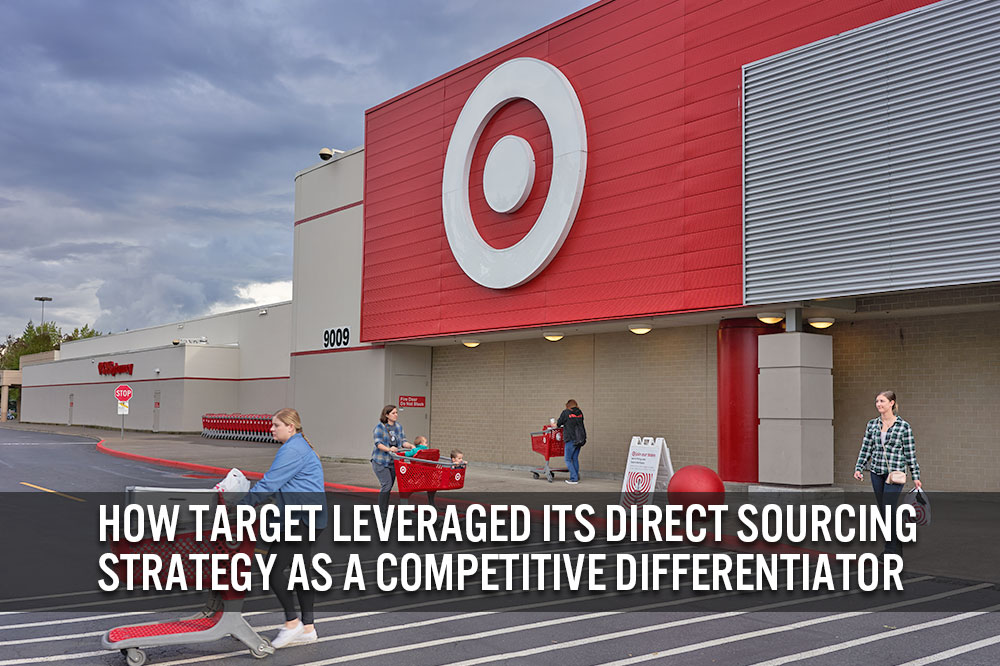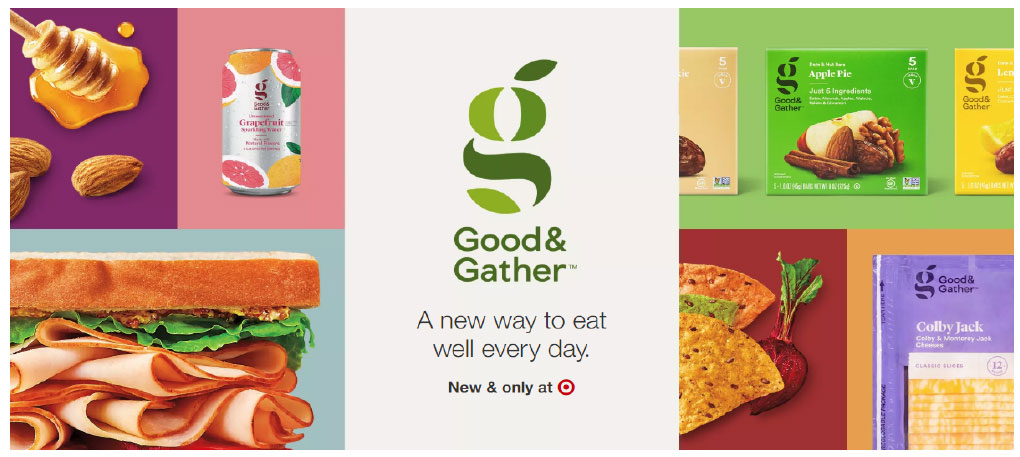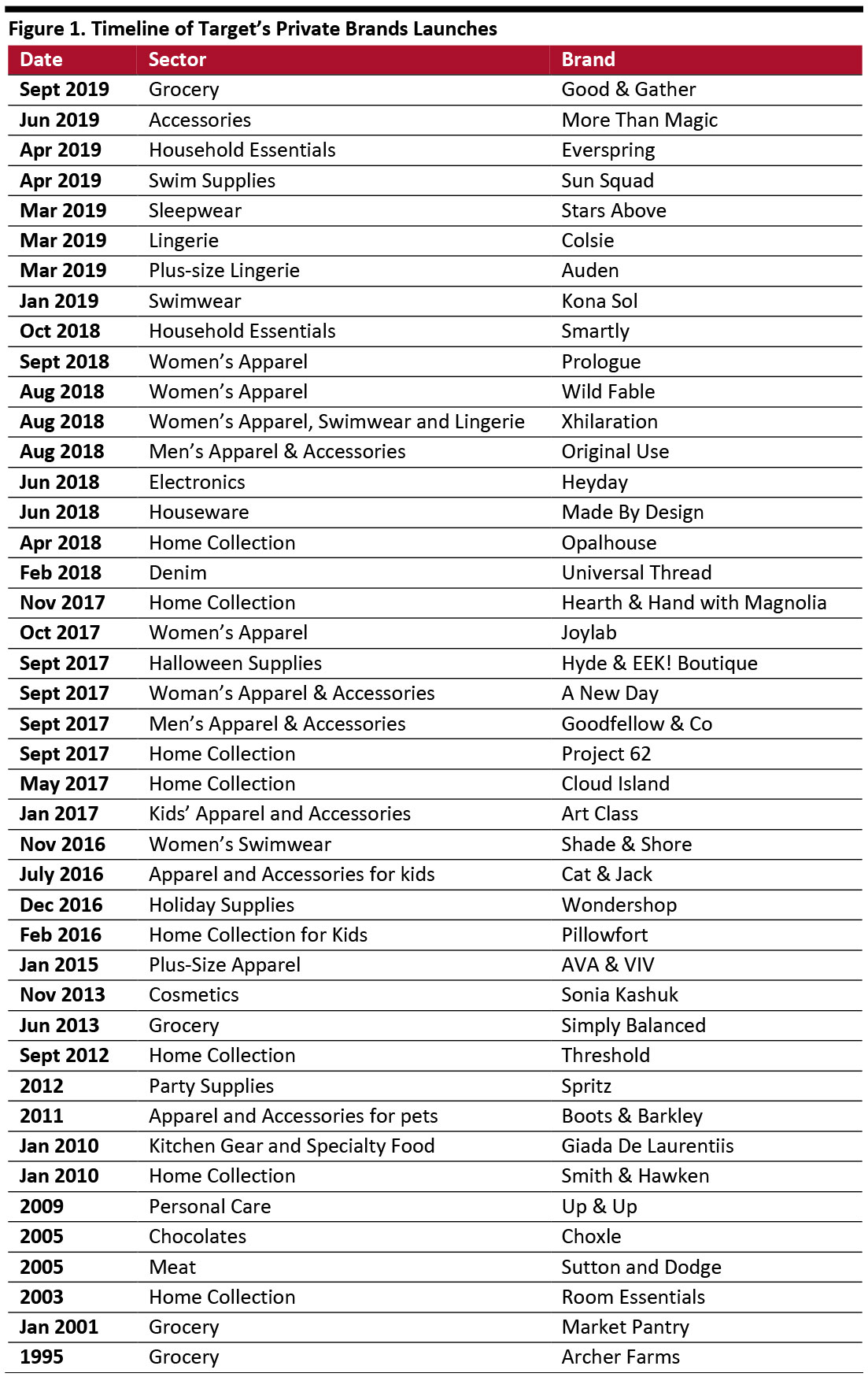
DIpil Das
While private-label brands are nothing new in retail, in recent years many companies have successfully repositioned store brands from a perception of low-priced, me-too products to premium quality merchandise offered at more economical price points than national brands.
Few retailers have been as successful as Target.
Target has a history of launching private brands in grocery, home collections, apparel and other categories
Owned and exclusive brands accounted for around one-third of Target’s sales in the year ended January 2019. But Target did not get there overnight: The company launched its first private brand, Archer Farms, in 1995, and has been building out its offering ever since.
After the success of Archer Farms, Target expanded its private brand offering into home collections, apparel and accessories. Most recently, Target launched Good & Gather, a move to update its private brand food line and tapping into the growing popularity of natural products.
See Figure 1, at the end of this report, for a timeline of Target’s private brands.
Target has built a robust line of nonfood private brands through direct sourcing – most especially from suppliers in China
In nonfood categories such as apparel, a major component of Target’s success in private brands has been its direct sourcing model.
In 1998, Target acquired Associated Merchandising (AMC), a retail merchandising sourcing services provider which was at the time was one of the industry’s largest independent sourcing and product development firms – in one fell swoop giving Target powerful direct sourcing, enabling it to move away from third-party sourcing. The result was lower cost and faster speed to market – and greater control over raw materials sourcing, production and distribution.
Following this move, in 2003, Target set up a sourcing center in Shenzhen, allowing it to double its volume of direct procurement from China. In August 2004, Target said its inventory position had grown 20% year over year, driven mainly by new store openings and same-store sale growth – but also attributed the rapid expansion to its strategy of aggressively developing direct import capabilities.
By 2006, about 50% of Target’s non-branded merchandise was being directly imported through AMC.
Fast forward to 2019, and Target sources from 2,722 registered manufacturing facilities in more than 49 countries – and China is by far the most important country of origin. Some 57.9% of Target’s direct sites are in China, according to our analysis of company reports.
Its Target Store Services division (TSS) is responsible for most of its product developing and sourcing, and works directly with factories in Asia. As of 2016, company reports showed TSS had 27 full-service offices, 48 quality-control offices and seven concessions throughout the world – all of which serve Target stores and Target.com exclusively.
Target’s supply chain transparency and responsible sourcing have bolstered the business as consumer preferences shift to brands that focus on sustainability
Target has for many years focused on sustainability issues.
In 2011, Target was a founding member of the Sustainable Apparel Coalition (SAC), a group of more than 200 brands, retailers, suppliers, non-profits and NGOs that work together to reduce the environmental and social impact of apparel and footwear products around the world. The coalition’s first major project was to create The Higg Index, a tool to help the industry measure the impact of materials, packaging, manufacturing processes and transportation on the environment.
In 2012, Target began asking business partners and the factories producing Target-brand products to use the Higg Index, a self-assessment – and the company uses these results as part of a much broader assessment of all suppliers to deliver individual, annual scorecards for each.
Company reports show Target conducted 1,630 factory evaluations in 2017, the latest year for which data is available.
In some highly-regulated product categories, the company requires all suppliers to meet the minimum standards outlined in the Good Manufacturing Practices (GMP) audit.
As a result of these and many other initiatives, the company has cut the amount of water used to produce the products it sells, reduced the amount of energy consumed from the start of the supply chain to the retail outlet, cut greenhouse gas emissions and improved the transparency of its supply chain to more easily see how and where products are made – most especially for grocery items such as cage-free eggs and ethical treatment of livestock.
Good & Gather: Target’s latest move extends various strengths into grocery
Target’s latest product line is Good & Gather, a food and beverage brand that focuses heavily on natural, ethically and sustainably sourced food products. Target will move many of its existing products now sold under the Archer Farms, Simply Balanced and Market Pantry brands to Good & Gather.
Good & Gather will include a wide range of food and beverage products, including innovative items such as avocado toast salad kits and beet hummus, alongside everyday staples such as milk, eggs and cheese. The company says by 2020 the brand will include more than 2,000 products from dairy to produce, to ready-made groceries.
[caption id="attachment_98476" align="aligncenter" width="700"] The colorful Good & Gather advertisement leverages Target’s sustainable reputation to better position its new line of naturally focused food offerings
The colorful Good & Gather advertisement leverages Target’s sustainable reputation to better position its new line of naturally focused food offerings
Source: Target [/caption] We provide a timeline of Target’s private-label launches below. [caption id="attachment_98497" align="aligncenter" width="700"] Source: Company reports/Coresight Research [/caption]
Source: Company reports/Coresight Research [/caption]
 The colorful Good & Gather advertisement leverages Target’s sustainable reputation to better position its new line of naturally focused food offerings
The colorful Good & Gather advertisement leverages Target’s sustainable reputation to better position its new line of naturally focused food offerings Source: Target [/caption] We provide a timeline of Target’s private-label launches below. [caption id="attachment_98497" align="aligncenter" width="700"]
 Source: Company reports/Coresight Research [/caption]
Source: Company reports/Coresight Research [/caption]